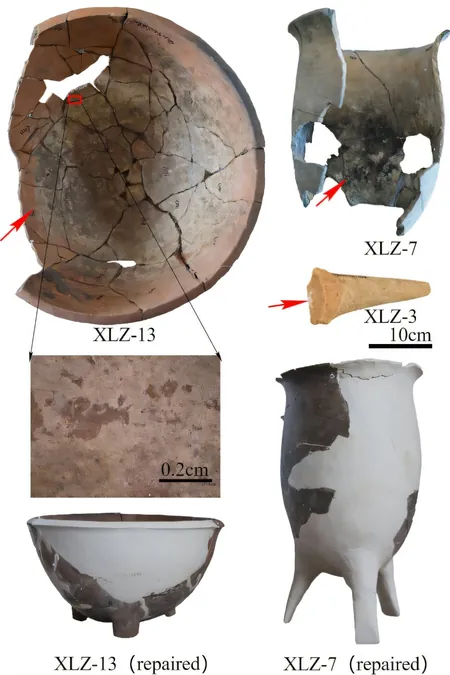
Archaeologists Uncover 8,000-Year-Old Bone Powder Cooking Technique in Ancient China!
2025-01-15
Author: Ling
Introduction
In a groundbreaking exploration, archaeologists, led by Xingtao Wei, have stumbled upon evidence of an ancient cooking practice involving bone powder, dating back nearly 8,000 years! This discovery, illuminated in a recent study published in the International Journal of Osteoarchaeology, sheds light on some of humanity's oldest culinary techniques at the Xielaozhuang (XLZ) site in Henan province, Northern China.
Significance of Xielaozhuang Site
The Xielaozhuang site is a significant archaeological treasure trove linked to the Peiligang culture (approximately 9,000 to 7,000 years ago), recognized as one of the earliest Neolithic societies in North China. This remarkable culture was not just about survival; they are credited with pioneering early fermentation techniques, creating the world's oldest known flutes, and potentially laying the groundwork for the very origins of Chinese script.
Excavations and Findings
Excavations carried out in 2017 and 2018 unveiled a variety of artifacts, including a settlement area, a burial ground, and three distinctive pottery Ding-tripods—ceramic vessels with a unique three-legged design. These vessels, dating from around 6,085 to 6,369 BC, contained remnants of food crust, hinting at the complex culinary practices of the time.
Research Goals and Discoveries
Intriguingly, the initial goal of the research was to investigate the temperatures involved in prehistoric alcohol production. However, the team, led by Dr. Tianxing Cui, inadvertently discovered traces of bone powder while analyzing the samples. Combining cutting-edge techniques, including Scanning Electron Microscopy and Fourier Transform Infrared Spectroscopy, they ventured into the chemical and mineral makeup of these ancient residues.
Analysis and Nutritional Implications
The analysis revealed a range of compounds typically found in bone, such as hydroxyapatite and various phosphates, pointing toward a sophisticated understanding of nutrition and resource utilization. Despite the advent of agriculture around 10,000 years ago in China, the Peiligang culture largely retained a foraging lifestyle, sourcing wild plants like acorns and Job's tears rather than relying solely on cultivated crops.
Innovation in Cooking Techniques
Remarkably, the evidence suggests that the process of grinding bones into a fine powder was a strategic innovation during the society's transition from a nomadic lifestyle to one based on agriculture. Historically, societies have resorted to extracting nutrients from bones as a way to bolster their diets, especially in periods of resource scarcity.
Advanced Techniques of Bone Processing
Prior to pottery, such practices remained largely theoretical due to the perishable materials typically used. The bones at XLZ were processed much more finely than those discovered at other sites, indicating a more advanced technique that likely involved the use of sandstone rollers found at the location.
Nutritional Enhancements and Community Settling
Researchers believe that this refined bone powder could enhance the nutritional value of wild plant foods when boiled together, forming a vital supplement as communities began to settle. Dr. Cui emphasizes the rarity of such findings, noting, "While this type of Ding is well-documented, the residues we find are not. The discovery adds to a growing narrative about the clever strategies utilized by early Neolithic communities."
Cultural Implications of the Discovery
The implications of this research resonate beyond just ancient culinary practices; it highlights an era where Neolithic societies were navigating a pivotal shift—a time when reliance on wild resources played a crucial role in developing settled lifestyles. As farming took root, communities like those at XLZ innovated, adapting their dietary habits and survival strategies in response to their changing environment.
Conclusion
This archaeological revelation opens up a tantalizing glimpse into the past, showcasing how our ancestors ingeniously combined nature’s offerings to sustain themselves during significant cultural transitions. Stay tuned as more discoveries emerge, charting the course of our ancient lineage!

 Brasil (PT)
Brasil (PT)
 Canada (EN)
Canada (EN)
 Chile (ES)
Chile (ES)
 Česko (CS)
Česko (CS)
 대한민국 (KO)
대한민국 (KO)
 España (ES)
España (ES)
 France (FR)
France (FR)
 Hong Kong (EN)
Hong Kong (EN)
 Italia (IT)
Italia (IT)
 日本 (JA)
日本 (JA)
 Magyarország (HU)
Magyarország (HU)
 Norge (NO)
Norge (NO)
 Polska (PL)
Polska (PL)
 Schweiz (DE)
Schweiz (DE)
 Singapore (EN)
Singapore (EN)
 Sverige (SV)
Sverige (SV)
 Suomi (FI)
Suomi (FI)
 Türkiye (TR)
Türkiye (TR)
 الإمارات العربية المتحدة (AR)
الإمارات العربية المتحدة (AR)